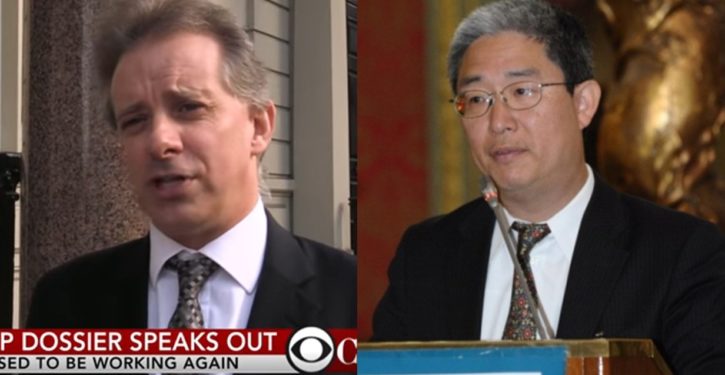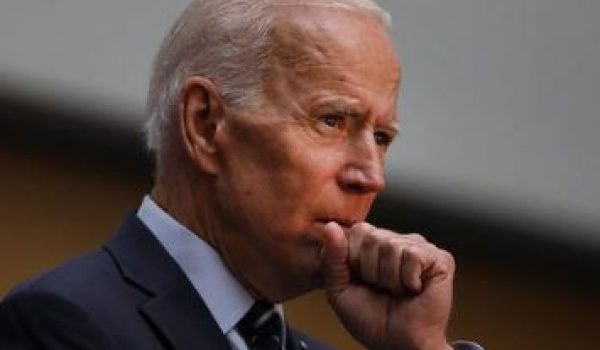
Chuck Ross of the Daily Caller News Foundation had an excellent article Monday summarizing new information about 2016 from a UK defamation lawsuit over the Steele dossier.
The gist of the information, which comes from testimony by Christopher Steele in March 2020, is that Steele met with Perkins Coie lawyers Michael Sussmann and Marc Elias in 2016, on dates the public was previously not aware of. The meetings were relevant to the lawsuit in the UK courts because it was brought by principals for Alfa Bank, the Russian-owned bank alleged in the Steele dossier to have communicated secretly with Trump via a server located in Trump Tower.
As Ross notes, the theory about Alfa Bank being involved in back-channel communications has long been debunked. But the new information from Steele’s testimony highlights an important point. Michael Sussmann, a former Justice Department official turned Perkins Coie lawyer, appears to have been Steele’s source for the Alfa Bank suspicions that made their way into a dossier memo in September 2016.
And the first meeting between Sussmann and Steele occurred on a very eye-catching date: 29 July 2016.

Ross covers a lot of territory in his exhaustive article, which I won’t recap here. One thing he didn’t touch on, however, is that 29 July wasn’t just two days before the launch of Crossfire Hurricane at the FBI. It was one day before Steele met with Bruce and Nellie Ohr at the Mayflower Hotel in D.C., on 30 July 2016.
In fact, the email exchange in which Steele and Bruce Ohr set up the breakfast meeting on the 30th sounds as if Steele’s purpose in coming to Washington, D.C. that week was to meet with someone else on a “short notice” basis. That someone else would logically have been Michael Sussmann.
Judicial Watch has the email exchange for us (see here for complete original). The morning of Friday, 29 July 2016, Steele emailed Bruce Ohr with this message:
Steele: Dear Bruce,
Just to let you know I shall be in DC at short notice on business from this PM till Saturday eve, staying at the Mayflower Hotel. If you are in town it would be good to meet up, perhaps for breakfast tomorrow morn? Happy to see Nellie too if she’s up for it. Please let me know. Best, Chris

In his March 2020 testimony in the UK, Steele said his meeting with Sussmann was on 29 July 2016. Meeting Sussmann would appear to have been his short-notice business that day.
Sussmann, as Ross and others note, is the conduit who later briefed FBI general counsel James Baker on the Alfa Bank narrative on 19 September 2016 – five days after the date of the memo about Alfa Bank in the Steele dossier. (The memo of 14 September 2016 is identified as “Company Intelligence Report 112.”)
But the Steele testimony from March appears to clarify that it wasn’t Steele feeding the Alfa Bank story to Sussmann. It was Sussmann who fed it to Steele – the day before Steele met with the Ohrs, which in turn was the day before Crossfire Hurricane was launched.
Here is Steele in the UK court proceeding:
“I’m very clear is that the first person that ever mentioned the Trump server issue, Alfa server issue, was Mr. Sussman [sic],” Steele told Hugh Tomlinson, a lawyer for the Alfa Bank owners, on March 17.
Steele went on to say that Fusion GPS founder Glenn Simpson instructed him at some point after the Sussmann meeting to write a report about Alfa Bank.
“I was given the instruction sometime after that meeting by Mr. Simpson,” said Steele, adding that the instruction from Simpson “was absolutely, definitely linked to the server issue.”
Says Chuck Ross: “It was not previously known whether Steele keyed in on Alfa Bank on his own initiative, or if someone else tasked him with investigating the bank.”
Ross then relates that “Steele said that he directed his dossier source to collect information from Russia about the bank.”
The point of going over this is to highlight that none of it reached Steele spontaneously. Steele had to solicit it from his “dossier source,” and did so at the behest of Sussmann.
Sussmann then later retailed some version of the Alfa Bank narrative to James Baker at the FBI. In October 2018, John Solomon reported on their September meeting at The Hill, and at the time, he didn’t report a specific date or topic. (I wrote a separate article nearly simultaneously, based on comments from Jim Jordan about the same closed-door Baker deposition from which Solomon sourced his article. Jordan didn’t give any names, but I speculated that the person who met with Baker in September 2016 may have been Michael Sussmann, a longtime associate of Baker’s from their DOJ days.)

Solomon did, however, have this, from Baker’s closed-door deposition to the House (emphasis added):
The sources said Baker identified lawyer Michael Sussman, a former DOJ lawyer, as the Perkins Coie attorney who reached out to him and said the firm gave him documents and a thumb drive related to Russian interference in the election, hacking and possible Trump connections.
Steele’s recent testimony puts a date on that, 19 September 2016, and clarifies that the topic was the Alfa Bank narrative.
Michael Sussmann, remember, was the Perkins Coie lawyer who called in CrowdStrike for the DNC at the end of April 2016, when the email cyber-intrusion had become apparent. Perkins Coie was counsel for the DNC and the Hillary campaign, and had contracted Fusion GPS for the opposition research on Trump that produced the Steele dossier.
The momentum of an operation, not an investigation – again
What has become increasingly apparent since 2017 is that the “Steele dossier” is a myth, from every perspective. At face value, it was never a report of information that actually came from spycraft investigation. And the Alfa Bank subplot is just one of several key threads in it that were concocted and fed in by actors connected to the Clinton campaign and the DNC. (The “Paul Manafort” narrative being another one, through Alexandra Chalupa and others in her orbit.)
It is extremely informative that Steele was in town and wanted to meet with the Ohrs because he’d been summoned to meet with Michael Sussmann, lawyer for Hillary Clinton and the DNC. That was the direction the energy flowed, and we should read that as meaning that Hillary and the DNC were where the initiative started. Notice who’s at the end of the chain: Bruce Ohr, the only government official in the mix, and one who actually served merely as a mule for the non-government political operators feeding the anti-Trump operation its cues.
Add to that the date of 22 July, on which the Australians reportedly informed a U.S. embassy official in London, Elizabeth Dibble, of Alexander Downer’s May 2016 chat with George Papadopoulos. This supposedly prompted the FBI to its “investigation” of Trump and Russia. The sequence of events between 22 July 2016 and the launch of Crossfire Hurricane – the triple play of Sussmann to Steele to Ohrs – does not bespeak a series of spontaneously emerging data points about Trump.
Rather, it looks like someone lining up his own game pieces on a board. It fits well with the pattern of events from the same period outlined here, when the anti-Trump operation in the broader Obama administration coalesced miraculously in July and August 2016, not around aides closer to Trump or those with more extensively demonstrated links to Russia, but around “people Stefan Halper knew”: Carter Page, Paul Manafort, and Michael Flynn. Halper’s ignorance of George Papadopoulos – already approached at someone’s behest by Joseph Mifsud – was then repaired within weeks.
Brennan
Which brings us to one more interesting aspect of this conjunction of personalities. Michael Sussmann was “Senior Counsel to the U.S. Department of Justice’s Computer Crime & Intellectual Property Section in Washington, D.C from 1997 to 2005.” But of more importance in some key ways, he “also provided counsel to FBI, U.S. Secret Service, U.S. Attorneys’ Offices and other federal (and state) agencies on the Wiretap and Pen/Trap statutes, Electronic Communications Privacy Act, online privacy and information security.” This meant he had extensive involvement in the use of electronic surveillance authority, for counterterrorism (the biggest concern at that time) as well as criminal and other national security applications.
In his years with Perkins Coie (since 2005), Sussmann’s public profile – lectures, panels, media appearances – has largely been about national security use of electronic surveillance, which in turn has been largely about terrorism.
James Baker, meanwhile, was in the DOJ Office of Intelligence Policy and Review (OIPR) from 1996 to 2007. His bio blurb at the link mentions that OIPR “later became part of DOJ’s National Security Division.” It goes on: “From 2001 to 2007, Mr. Baker served as counsel for intelligence policy and head of OIPR. In this position, he developed, coordinated, and implemented national security policy with regard to intelligence and counterintelligence matters for the department. Moreover, he provided the attorney general, the U.S. intelligence community, and the White House with legal and policy advice on a range of national security issues and conducted oversight of the intelligence community, including the FBI, on behalf of the attorney general.”
The bio then notes this: “In 2006, Mr. Baker received the George H.W. Bush Award for Excellence in counterterrorism—the CIA’s highest counterterrorism award.”

John Brennan was the CIA’s top counterterrorism man when he stood up the Terrorist Threat Information Center (TTIC) in 2004, after taking over its predecessor, the CIA Counterterrorist Center (CTC), in 2002, from its longtime head J. Cofer Black (late of the Burisma board of directors in Ukraine). Brennan became the interim director of the follow-on to the TTIC, which is today’s National Counterterrorism Center, leaving that position in 2005. Cofer Black, notably, went from the CIA CTC to the State Department, where he held an ambassadorial post in counterterrorism from 2002 to 2004.
Brennan went on later to be Obama’s counterterrorism “czar” from 2009 to 2013, and then became the CIA director in Obama’s second term. As in so many cases, Brennan had reason to know who Michael Sussmann and James Baker were. As a top policy-maker in the early 2000s for counterterrorism intelligence, much of which was taken up with electronic surveillance as a chief source, he very probably knew both of them.



